![]()
![]()
![]()
Use LEFT and RIGHT arrow keys to navigate between flashcards;
Use UP and DOWN arrow keys to flip the card;
H to show hint;
A reads text to speech;
46 Cards in this Set
- Front
- Back
|
What is a market? |
A structure that allows buyers and sellers to exchange good and services. |
|
|
What is a buyer? |
Consumers; people that demand goods and services. |
|
|
What is a seller? |
Businesses or firms; people that sell goods and services. |
|
|
What is the law of demand? |
Quantity demanded rises when prices fall and falls when prices rise, ceteris paribus. |
|
|
Define the following symbols: D, P, Q(d). |
D = Demand. P = Price of product. Q(d) = Quantity demanded of product. |
|
|
What does a demand curve look like on a graph? |
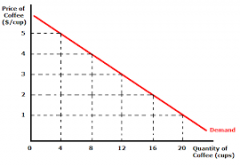
|
|
|
What are the major determinants of demand? |
Consumers Related good's price - substitutes and complements Income - normal and inferior Tastes/preferences Expectations |
|
|
If # consumers ↑, D _____. If # consumers ↓, D _____. |
↑; ↓. |
|
|
If the price of a substitute ↓, D _____. If the price of a substitute ↑, D _____. |
↓; ↑. |
|
|
If the price of a complement ↑, D _____. If the price of a complement ↓, D _____. |
↓; ↑. |
|
|
If normal good & income ↑, D _____. If normal good & income ↓, D _____. |
↑; ↓. |
|
|
If inferior good & income ↑, D _____. If inferior good & income ↓, D _____. |
↓; ↑. |
|
|
If tastes ↑, D _____. If tastes ↓, D _____. |
↑; ↓. |
|
|
If future price is expected to ↑, D(now) _____. If future price is expected to ↓, D (now) _____. |
↑; ↓. |
|
|
What causes a movement along the demand curve versus a shift in the demand curve? |
Movement - change in price; Shift - CRITE. |
|
|
What is quantity demanded? |
The amount of a good or service that buyers are willing and able to purchase at the current price. |
|
|
What is the law of supply? |
The quantity supplied of a good rises when the price of a good rises and falls when the price falls, ceteris paribus. |
|
|
Define the following terms: S, P, Q(s). |
S = Supply curve. P = Price of product. Q(s) = Quantity supplied of product. |
|
|
What does the supply curve look like on a graph? |
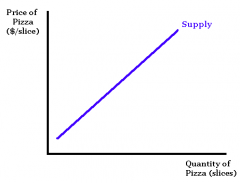
|
|
|
What are the major determinants of supply? |
Sellers Input Prices Regulation - taxes and subsidies Other potential output's price Technology Expectations |
|
|
If # of sellers ↑, S _____. If # sellers ↓, S _____. |
↑; ↓. |
|
|
If the price of an input ↑, S _____. If the price of an input ↓, S _____. |
↓; ↑. |
|
|
If taxes ↓, S _____. If taxes ↑, S _____. |
↑; ↓. |
|
|
If the government subsidizes a firm, S _____. If government removes a subsidy, S ______. |
↑; ↓. |
|
|
If the price of other potential output ↑, S _____. If the price of other potential output ↓, S _____. |
↓; ↑. |
|
|
If technology improves, S _____. If technology gets worse, S _____. |
↑; ↓. |
|
|
If future price is expected to ↓, S(now) _____. If future price is expected to ↑, S(now) _____. |
↑; ↓. |
|
|
What causes a movement along the supply curve versus a shift in the supply curve?
|
Movement - change in price; Shift - SIROTE.
|
|
|
What is quantity supplied? |
The amount of a good or service that producers are willing and able to sell at the current price. |
|
|
Identify why price and quantity demanded are negatively related and why price and quantity supplied are positively related. |
When the price of a good is higher, you want less of that good (demand is less - negatively related). When the price of a good is higher, suppliers want to and will supply more of that good (supply is more - positively related). |
|
|
Differentiate between quantity demanded and demand; and quantity supplied and supply.
|
QD is the movement of a demand curve, caused by change in price, and demand is the actual curve; QS is the movement of a supply curve, caused by change in price, and supply is the actual curve.
|
|
|
Tell why a change in a product's price does not shift either the demand curve or the supply curve. |
Price is the y-axis of both curves; if you are changing the y-coordinate, you are simply moving the point along the graph, rather than shifting the entire thing. |
|
|
Using the follow "demand schedule," create a demand curve: Price = $5/lb. Quantity = 20,000 lbs. Price = $4/lb. Quantity = 40,000 lbs. Price = $3/lb. Quantity = 60,000 lbs. Price = $2/lb. Quantity = 80,000 lbs. Price = $1/lb. Quantity = 100,000 lbs. |
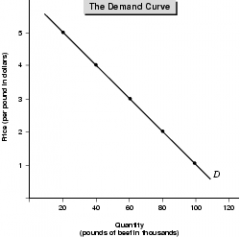
|
|
|
Using the following "supply schedule," create a supply curve: Price = $15 Quantity = 100,000 baseball caps Price = $20 Quantity = 125,000 caps Price = $25 Quantity = 200,000 caps Price = $30 Quantity = 350,000 caps |

|
|
|
State the law of demand and supply. |
Law of demand - If P↑, QD↓ and vice versa. Law of supply - If P↑, QS↑ and vice versa. |
|
|
Identify and explain the concept of equilibrium price and equilibrium quantity. |
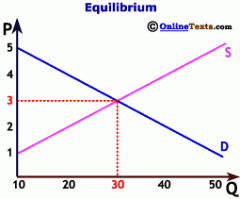
Equilibrium price is the price at which the quantity supplied is equal to the quantity demanded ($3). Equilibrium quantity is the amount at which the quantity supplied is equal to the quantity demanded (30). When either or both the supply and demand curve shift, the EP and EQ shifts as well. |
|
|
A demand curve shifts to the right. Illustrate graphically equilibrium price and quantity. |
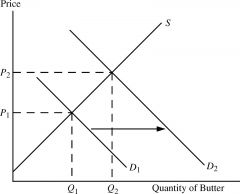
EP shifts ↑; EQ shift ↑. |
|
|
Explain the effects of changes in demand and supply on equilibrium price and quantity.
|
Demand → = EP↑ and EQ↑. Demand ← = EP↓ and EQ↓.
Supply → = EP↓ and EQ↑. Supply ← = EP↑ and EQ↓. If D and S both increase = EQ↑ and EP can be higher, lower, or stay the same. If D and S both decrease = EQ↓ and EP can be higher, lower, or stay the same. If D→ and S← = EP↑ and EQ can be higher, lower, or stay the same. If D← and S→ = EP↓ and EQ can be higher, lower, or stay the same. |
|
|
What is a surplus? |
A condition that occurs when the quantity supplied is greater than the quantity demanded. |
|
|
What is a shortage? |
A condition that occurs when the quantity demanded is greater than the quantity supplied. |
|
|
Give an example of the rationing function of prices and how changes in price may eliminate shortages and surpluses in markets.
|
Goods are rationed by suppliers when there is a shortage (the price is below the equilibrium point). Suppliers will raise prices so they can make a better profit and so that the products are going to the people that value them the most. The opposite is true of a surplus, so the suppliers can clear the market. The goods become devalued. Changes in price may eliminate shortages and surpluses in markets by bringing the quantity supplied/demanded of the good to equilibrium.
|
|
|
What is a price ceiling? |
A legally established maximum price for goods or services. |
|
|
Explain why a price ceiling is imposed? What are its intended and unintended consequences? |
A price ceiling is imposed to help low-income individuals and families to be able to afford necessities. This is its intended consequence. Unintended consequences include a shortage of the good, the supplier using cheaper resources to create the good or changing the size of the good, and the development of a black market. |
|
|
What is a price floor? |
A legally established minimum price for goods or services. |
|
|
Explain why a price floor is imposed? What are its intended and unintended consequences? |
Price floors are imposed because of the political pressure of suppliers to keep prices high and to increase the supply of a good. Its intended consequence is production increases, and it is attractive to producers. Unintended consequences include a surplus of milk, a smaller demand than the equilibrium quantity, and a lower black market price to eliminate the leftover product. |
|
|
What is a black market? Why would one develop? |
A black market is an illegal market that arises when price controls are in place. They usually go underground and charge higher prices to give customers the goods they want. They usually develop due to a binding price ceiling (causes a shortage of goods) or a binding price floor (a surplus of goods). |

